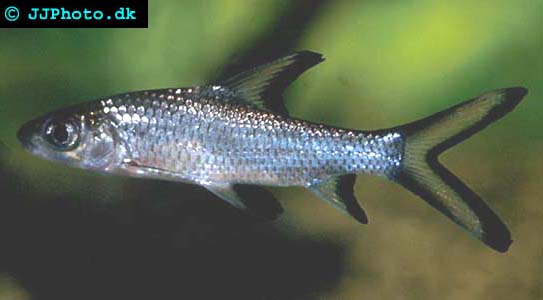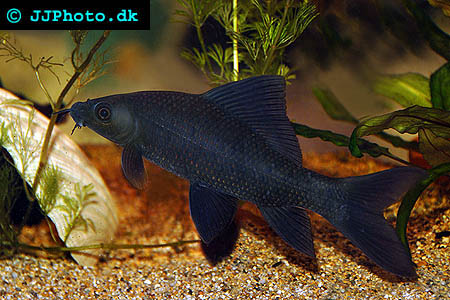This article will, despite its name, not really be about freshwater sharks such as the bull shark which can frequently be found in freshwater, but rather be about the different types of minnows that are commonly referred to as freshwater sharks even though they aren’t even closely related to the true sharks.
The most common types of so called freshwater sharks are found in the genera Balantiocheilos, Epalzeorhyncho or Labeo, but quite a few species from other genera are also referred to as sharks from time to time without actually being true sharks.
The genus Balantiocheilos contains one single type of so called freshwater shark, Balantiocheilos melanopterus. This species is commonly known as Bala shark and might be the most common type of freshwater shark of them all. Bala sharks live in Laos, Malaysia, Thailand and Indonesia and can grow to a size of 36 cm / 14 in. This type of “freshwater shark” is hardy and will accept most types of food. They are very adaptive in regards to water conditions but prefer a pH of 6-8 and a water temperature of 22-28 degrees C / 72- 82 degrees F. This species is often sold to as fry to unsuspecting aquarist who plan to keep them in their small or medium sized community aquariums, but Bala sharks should only be bought if you have room for a school of these fishes and can house them as they reach their full size. An interesting fact about the Bala shark is that it – just like all other types if so called freshwater sharks – lacks teeth.
The genus Balantiocheilos contains five types of freshwater sharks of whom the most widely known and most popular are the Red tailed shark Epalzeorhynchos bicolor (earlier considered a member of the genus Labeo) and the Rainbow shark Epalzeorhynchos frenatum. The species in this group is found in Far East Asia. The various freshwater sharks in this group can all be cared for in a similar way. They can all be kept in water with a neutral pH-level and a water temperature of 24-26 degrees C / 75-79 degrees F. Some species are hardier and can accept larger differences in regards to pH-value and temperature. Always research the particular species of freshwater shark you are looking at before buying it. It is very important to have a well covered aquarium when dealing with these sharks since they are excellent jumpers.

Bala Sharks - A type of freshwater sharks. Copyright www.jjphoto.dk
The genus Labeo contains a total of 103 described species of which only one (or perhaps two) species are common in the aquarium trade and known as a type of freshwater shark. The most common one is the Black shark (Labeo chrysophekadion). This beautiful night black “freshwater shark” grows largest of all the different types of freshwater sharks that are normally kept in aquariums. It can reach a size of 82 cm / 32 in which in reality only makes it suitable for public aquariums and (the very small crowd of) hobby aquarists fortunate enough to have really large aquariums. The Black shark can be very aggressive towards other fish of its own species and is best kept without other Black sharks present unless the aquarium is large enough for several territories to be established. Just like all types of freshwater sharks in the genus Balantiocheilos, the Black shark prefers an aquarium with a number of suitable hiding places. Black sharks do best if the temperature is kept at 24-27 degrees C / 75-81 degrees F and the pH at 6.5-7.5.

A Black Shark – labeo Chrysophekadion - A type of freshwater shark. Copyright www.jjphoto.dk
There are a number of other fish that from time to time is referred to as freshwater sharks and thereby could be considered “types of freshwater sharks” but these species are either not very usual in the trade or is more commonly know under names that don’t falsely brand them as sharks. You can rest assured that anything you might find in your local aquarium shop that is labeled freshwater shark isn’t really a freshwater shark even if there are true sharks that live in freshwater large parts of their life in the wild. (Some species of true sharks are even suspected to live out their entire life in freshwater, but this has not yet been confirmed.)



